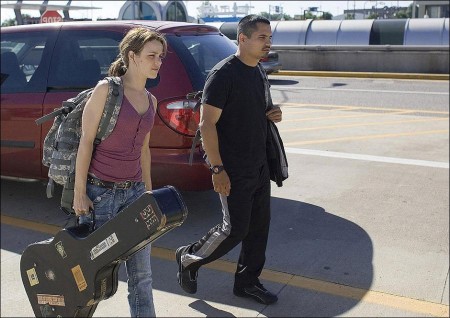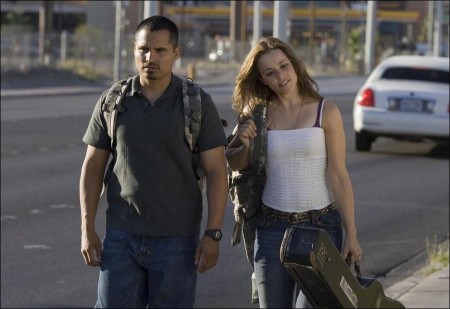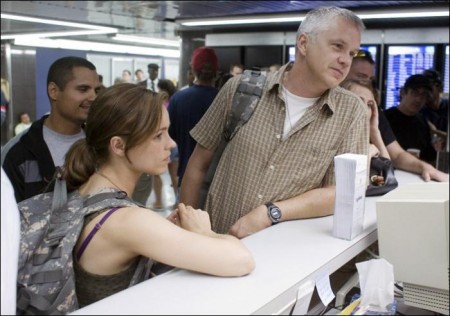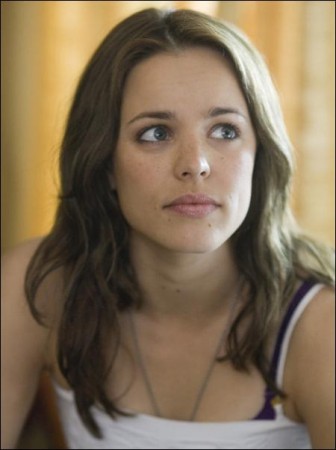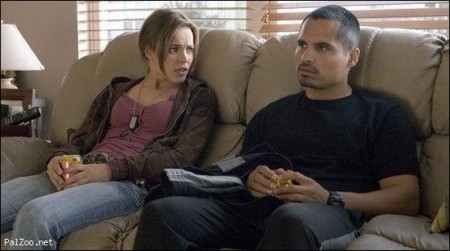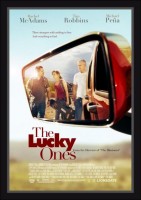Tagline: Three strangers with nothing to lose. And everything to find.
T.K. Poole (Michael Peña), Colee Dunn (Rachel McAdams) and Fred Cheever (Tim Robbins) arrive in New York from Germany only to find their connecting flights canceled due to a power outage. Anxious to get to their respective destinations, they agree to share a rented minivan to suburban St. Louis where Cheever is to reunite with his wife and teenage son. From there, the other two plan to fly to Las Vegas where the macho T.K. wants to make an important stop before seeing his fiancée and the tough yet naïve Colee plans to pay a visit to a fallen fellow-soldier’s family.
But when Cheever’s homecoming turns out to be a far cry from what he anticipated, the trio’s one-day drive expands into an impromptu cross-country marathon. Along the way, they experience a string of surprising adventures ranging from the hilarious to the heartbreaking. As their interstate journey takes them from a barroom brawl to a high society dance to a bizarre Sunday morning church service, T.K., Colee and Cheever discover that home is not quite what they remembered and the unlikely companionship they’ve found in one another might be what matters most of all.
A humorous and timely drama about coming home, The Lucky Ones stars Rachel McAdams (The Notebook, Wedding Crashers), Tim Robbins (Mystic River, The Shawshank Redemption) and Michael Peña (Crash, World Trade Center), and is directed by Neil Burger (The Illusionist) from a screenplay by Burger and Dirk Wittenborn.
About The Production
“The Lucky Ones is a road movie, and like all classic road movies, it’s an epic emotional journey,” director Neil Burger says. “The three characters have been out of the country for some time and want nothing more than to get home and reconnect with family. But life is never that simple.”
The essential fact, of course, is that the three characters are soldiers returning from tours of duty – TK is an experienced Army sergeant, Colee a young private, and Cheaver an older reservist. Says Burger, “I thought what better way to look at the country than through the eyes of people who’ve been away serving their country. They’re just trying to be normal, have a good time, find love. It’s funny and heartbreaking.”
“The movie I looked at the most when writing The Lucky Ones,” says Burger, “Was a great Jack Nicholson movie called The Last Detail directed by Hal Ashby. It’s a very different story but it has a similar tone of humor and heartbreak. You get a real sense of what life was like in 1973 America and I wanted to do the same thing with The Lucky Ones – to have it be a real snapshot of today.
“While I was editing my last movie, The Illusionist, I began writing notes for a story on soldiers coming home,” says Burger. “To me, the war was less the issue than the question of America now. Where are we as a people at this point in time? I wanted to somehow take the temperature of the country during this highly charged political moment.”
Burger and co-writer Dirk Wittenborn (Pharmakon, Fierce People) had been looking for a story to collaborate on for years. “I told him what I was working on and he quickly joined me on the project. I had written my last two movies alone but I was lucky to have Dirk on this rambling and far-reaching story.” They started with a rough concept of people coming back to the States on convalescent leave. Wittenborn knew a doctor at Balad Air Force base and that was the beginning of their research. After contacting soldiers that had been over there, they began methodically fleshing out the premise of a cross-country trip and the trajectory of the three characters’ lives as they become reacquainted with country-regionplaceAmerica.
“In some ways we wanted to write a love letter to placecountry-regionAmerica,” Wittenborn says, “but a clear-eyed love letter that included our concerns about these people, one that didn’t shy away from the realities.”
The Lucky Ones is a road trip movie in the proud tradition of The Last Detail, Little Miss Sunshine, Sideways and many other motion pictures, but it approaches the genre in its own unique way, according to producer David Levien. “It’s got the staples of any road film — the travel and the elements that don’t go smoothly — but it hits those moments in ways that you don’t see coming,” says Levien, who with his partner, Brian Koppelman, produced Neil Burger’s first two films, Interview With the Assassin and The Illusionist.
“The thing about this movie that struck us from the beginning was its fresh and original tone in the way it handles serious topics,” adds Koppelman. “Some movies about returning soldiers have been politically laden, but this movie plays against all those expectations. It’s such an audience-pleasing ride.”
With screenplay in hand, Burger and Wittenborn approached Bill Block and Paul Hanson and won the backing of their company, QED International, which fully financed the film and is distributing it internationally. “I was drawn to this story from the moment I read it,” says Block, QED’s founder and chief executive officer and one of the film’s executive producers. “In a time where the majority of perspectives on the war are dark and fail to address the positive side of the human spirit, Neil has created a film that translates national optimism and the sense of togetherness.” Hanson, chief operating officer of QED International and executive producer of the film, says: “QED wants to make films that are very high quality and have a unique take on their material. Working with great filmmakers is another priority for us, and Neil Burger fits that description in spades.”
“The Lucky Ones couldn’t be more different than my last film The Illusionist,” says Burger. “But in a way they’re connected. They both deal with issues of truth: in the earlier film, truth versus illusion and faith; in the The Lucky Ones, truth versus self-delusion and outright lies.” The humor is a departure too – the movie walks a very fine line between comedy and drama. “In this story, you can’t have one without the other,” says Burger. “But the humor is key, it’s like a Trojan horse – it makes you let down your guard and let the characters into your heart.”
About the Characters
Each character in the movie is somehow representative of America. In the case of Colee Dunn, played by Rachel McAdams, she’s the heart of America, optimistic and maybe a bit naïve about the world. She’s a fighter, a tough-talking but somewhat lost young woman with an unhappy family life, who fantasizes about living with her dead boyfriend’s parents in Las Vegas.
“I liked the ambiguity of the script,” McAdams says when asked what attracted her to this project. “I liked that sometimes I wasn’t sure whether I should laugh or not.”
“Colee’s got all her eggs in one basket,” McAdams continues. “She’s hoping this family who’s never met her will take her in, so she’s really living in a fantasy world. She’s seeking out fellowship and brotherhood, and I think that’s what she loves about the military. She really doesn’t have anyone, but she finds TK and Cheever and discovers a lot more about herself in losing her fantasy.”
The three soldiers are on an emotional roller coaster, McAdams says. “When you come back from such an intense experience as war, you’re not quite sure where you fit in anymore. You don’t know how to describe your experience to people, and you feel really lonely, yet you’re seeking out connections. You try to reintegrate into what used to be your home, and it’s a really odd place to be.”
Tim Robbins plays Fred Cheaver, an older member of the Army reserve who’s been called up to duty and taken away from his wife and son. He’s the guy getting the shaft, the forgotten American, and he wants nothing more than to get back home to see his family.
“I’m in my 40s, Michael Peña’s character is a hotshot and Rachel McAdam’s character is bright, optimistic and very religious,” Robbins says. “There’s no reason we should be in the same car — we’re not alike — but that’s where I think the humor comes in.”
Robbins was attracted to the project by the spirit of the three soldiers who, “in the worst situations try to find a way to get their heads above water. We didn’t want to do a maudlin, depressing story of three returning country-regionplaceIraq veterans. We wanted to find their humanity; we wanted to find their sense of humor. We wanted to show that they are survivors who find the way to recapture the joy in their life.”
Cheever’s own survival instincts must come into play when he discovers that his wife wants a divorce and that his civilian job may not be waiting for him. “I have to figure out first of all how I’m going to keep going forward and also how I’m going to pay for my kid’s college education,” Robbins says.
Michael Peña plays Sgt. TK Poole, a cocky natural-born leader. He’s the go-it-alone placecountry-regionAmerica, the cowboy, the know-it-all. Now he’s been wounded in his private parts and is afraid he won’t be able to perform when he visits his fiancée.
“It’s a devastating blow,” Peña says, “because he’s a pretty self-assured kind of guy. So when he gets home he has a plan to go to CityplaceLas Vegas to get a real pro to make it work before he sees his fiancée. But while traveling with Colee and Cheever across the country, he realizes a couple things about himself. He’s got this façade of being the macho guy, because that’s all he grew up with, but along the way Colee and Cheever help him to become the person that he is underneath his war face.”
Throughout their journey, an unspoken presence haunts TK, Cheever and Colee — the war — which the three characters never really talk about, although at least two of them will be returning to it after their leave. “The war’s a character in the movie,” Robbins says. “There’s no denying that it’s always underneath, so when the three are talking about all these other things, there is a certain subtext that’s never spoken. They keep it suppressed, but it informs everything else.”
Summing up the relationship that develops among TK, Cheever and Colee during their eventful road trip, Wittenborn says: “There’s a kindness and a sort of spiritual romance that takes place between the three of them. They really heal each other. Maybe they don’t find what they thought they were looking for in country-America, but they certainly find something in one another that they didn’t have before this journey began.”
Even though there aren’t battlefield scenes in the movie, each actor wanted to be prepared for his or her role, to have a real sense of the life of the soldier, so that even in civilian clothes back home in America, they could be true to the spirit of their characters. In Peña’s case, he had already received his military training for the film he had just completed, Lions for Lambs, in which he played a soldier in Afghanistan.
McAdams, who wanted to understand the mindset of a soldier who had just come back from Iraq, trained for two weeks at Fort Campbell, Tennessee. She was placed in a military police unit that had been deployed in Iraq and was preparing to return to that country. For the first week of her training, no one in her unit, other than her commander, her platoon leader and her platoon sergeant, knew that she was the actress Rachel McAdams.
“She can take a punch,” says Army Maj. Todd Breasseale, who served as the film’s military consultant, “and she can do physical fitness training with the best of them. She’s an expert marksman now. The assault course — she nailed it. I think you’re going to see her training in this picture. She brings a nuanced quality to this picture that you’re not going see from someone who has not at least attempted to walk in the shoes of a soldier who’s done the real work.”
Tim Robbins plays a reservist who is leaving the armed forces and so he made contact with a reserve unit in New Jersey and with soldiers in New York. He went through pre-deployment training, talked with the family members of deployed soldiers, and researched the unique challenges that members of the U.S. Army Reserve and National Guard face.
But that wasn’t his only exposure to the military experience. During evenings when filming had finished for the day, he was often approached by veterans, some of them deeply distressed, who wanted to share with him war experiences that they kept even from their own families. Robbins says: “I felt it was an honor and a kind of responsibility to listen to them. But it was emotionally exhausting. It was a profound experience to tell the story in the daytime and hear the real stories at night.”
On the Road
Filming began in May 2007 and lasted for eight weeks. During that time, the cast and crew formed a close bond as they traveled to locations in Illinois, New York, Pennsylvania, Missouri, Colorado, and finally to Las Vegas. “We were like a traveling circus,” says director Neil Burger.
About a quarter of the film takes place in the minivan. Screenwriter Wittenborn recalls that at the beginning someone said: “`You guys are going to write a movie that all takes place in a van? What are you, insane?’ But I was very confident, having seen Neil’s other two movies, The Illusionist and Interview With the Assassin. They were so visually clever; he shot them in such an interesting way.”
“I wanted to really take the trip that the characters do, to actually see them in the places where the story happens,” says Burger. “So when you see them crossing the Mississippi River St. Louis, that’s really them in the car. There had been talk in pre-production of shooting on stage, or even in Canada, but I felt it was important to be as authentic as possible, to be true to the experience – especially in a movie that deals with issues of truth and lies. So we took about 100 crew and actors on a road trip across the country. It was crazy.”
“It’s challenging shooting in a car,” continues Burger. “I wanted a loose feel to the camera work, a caught-on-the-run kind of feel. I wanted it to seem real and I wanted the actors to drive when possible. And because the characters would be driving on highways, that’s where we shot. But it’s a risky proposition. Besides all the logistical difficulties of shooting on a highway – permissions and state police – how do you have an actor acting, laughing, screaming, whatever, and also driving safely at 60 mph?”
For high speeds the production developed its own special minivan, customized so it could be controlled by a professional driver mounted in a roll cage attached to the roof. The bizarre looking, top-heavy vehicle reached speeds of 65 miles per hour with the driver, firmly strapped in and helmeted, steering the minivan from on high. Says Burger, “It was great because we could avoid unwieldy trailers and towing, and the minivan would still handle like a real car. The guy could parallel park the thing from the roof.”
Another challenge of shooting inside the minivan — beyond keeping it fresh visually – was where to put all the actors and crew. “We were trying not to restrict the angles,” Burger says, “so everything else had to be hidden, including me. It’s a tiny space, and you’ve got three actors in there, a camera operator and an assistant cameraman, so there were very few places left to sit. As a result I was often stuck lying down in this tiny little well in the back of the minivan, the only place where I couldn’t be seen, with a monitor and operating the sound myself.”
They were shooting in the height of summer, sometimes in the desert. Temperatures often topped 100 degrees, but they had to drive with the air conditioner off because its noise interfered with the sound recording. Peña says: “The temperature’s like through-the-roof hot, but Burger’s in the back with his little monitor and saying, `Good, yeah, that’s good. Now, Rachel, say it slower. Good, good.’ And then instead of saying `cut,’ he’d say, `A.C. on.’”
The camaraderie among the actors and crew was real and strengthened by their shared experiences of filming on the road far from their homes and star trailers. They stayed in the same hotels and motels, ate together and spent more time with each other than would have been the case if this had been a movie filmed in studios. At one point a major tornado warning shut down filming at a Chicago-area church. Hundreds of extras were standing around with nothing to do when the actors began an impromptu musical session. “Everybody was getting tired,” Peña says, “and we just wanted to jam out, so I started playing the drums and Tim hopped on with the guitar and people started singing along. It was really really cool.”
Adding to the close-knit nature of the production, according to producer Rick Schwartz, was the decision early on that there would be no personal assistants for the actors or the filmmakers. “On some films if you want to deal with an actor on something you go through his people, but this was as close to a real road trip as possible, and the decision paid off in the chemistry with all three actors and the crew. We all really felt like we were in this together.”
“There are always issues inherent in going to location everyday,” Schwartz adds, “finding those locations and dealing with different rules and sometimes different crews in different states. I hadn’t encounter these obstacles in other movies where you go to a studio and sit for four months, but it paid off, and I would do it this way again in a heartbeat.”
“What was unique about this production,” says Burger, “is how the three actors spent almost every scene and every shooting moment together in that van. Like the characters in the story, they began as three strangers but over the course of their time together, they forged a real friendship, a real connection with each other.”
Production notes provided by Lionsgate Films.
The Lucky Ones
Starring: Rachel McAdams, Tim Robbins, Michael Pena, Molly Hagan, Mark L. Young, Howard Platt, Arden Myrin
Directed by: Neil Burger
Screenplay by: Neil Burger
Release: September 26, 2008
MPAA Rating: R for for strong violence including some torture, and for language.
Studio: Lionsgate Films
Box Office Totals
Domestic: $266,967 (100.0%)
Foreign: —
Total: $266,967 (Worldwide)
